hey friend!
I'm Martina.
I provide practical, time-saving strategies that actually work—so you can engage your students, teach effectively, and reclaim your time from the exhausting planning-grading cycle.
Browse Our ELA Resources
Classroom Organization in Middle School and Upper Elementary | Teacher Materials | Part 2
This middle school English teacher grading strategies for upper elementary and middle school grading and assessment blog post is part of a classroom organization series. This is part eight of ten blog posts all about how I organize different areas of my classroom. Click on any of the links to be taken to each of the posts in the series:
- One: Lesson Planning and Lesson Materials Organization
- Two: Teacher Materials Organization
- Three: Student Materials Organization
- Four: Classroom Routines and Novels Organization
- Five: Classroom Library Organization
- Six: Book Clubs, Novel Sets, and Literature Circles
- Seven: Small Group Organization
- Eight: Grading and Assessment
- Nine: Long-Term and Short-Term Sub Planning
- Ten: Back to School Organization
CLICK HERE to get the Organization Overhaul Complete Classroom Course plus bonus resources for each module.
CLICK HERE to get the complete printable organization E-Book.
Get the Organization Overhaul Complete Classroom Course
Teacher Materials Organization
One of my favorite teacher organization tools is binders. I am the self-proclaimed queen of binder organization, but I want to be clear that I am also pretty good about not having any unnecessary copies. For example, when I need Interactive notebook copies, I just go to the digital file (either on my flash drive or on TPT) and print off 50 copies of the page I need for that week’s lessons. My binders only have hard copies of things I use daily and/or weekly or copies of stuff I can’t easily find again. Occasionally I will have hard copies of stuff that I may not use weekly, but have found it easier to have the copy ready, as opposed to searching through the PDF.
For example, I used to assess my 5th graders using YoungTeacherLove’s (Kristine Nannini) Common Core Math Assessments. It was easier to have a binder with five sections for each Common Core Strand, so I could grab the assessment I needed, rather than trying to scroll through the file each time.
It was also easier to have the answer keys right there, instead of, again, trying to find them each time.
The point is to have the minimum in binders. As part of your exclusive content, I have included multiple editable binder label options.
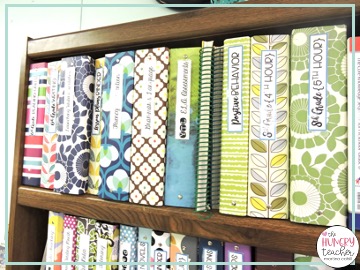
TEACHER MATERIALS ORGANIZATION
What is in the binders? These are the most common binders I have:
- I have a binder for each class I teach, where each student has their own section. This is for reading conferences. This means I have about 24 dividers in each of these. I currently have 4 binders like this for my four English classes.
- I have a binder for each grade level’s novel units. This has the lesson plans for the novel we are currently reading. So if I’m reading Holes, I have the entire unit (questions, prompts, vocab, etc.) printed to reference every day and don’t have to go digging for them each week or day.
- Small group binder for lessons, anecdotal notes, and materials.
- RtI and SPED documentation binder so I can do it quickly every day.
- Close reading, articles, non-fiction or news print offs for small group lessons, so I don’t have to go hunting every time.
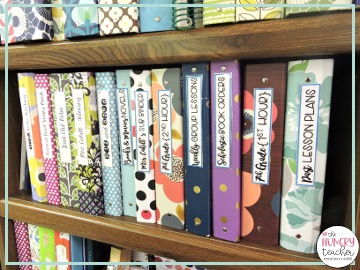
This isn’t the best picture, but these are my two BIG binders (at the top of the table). These are the ones that I have a section for each student. The binder below was my small group binder.
Essentially these are all my notes from conference and small group (I will show more of these later) but essentially these are the binders I use for report cards, assessment, and data collection. They also guide my whole group and small group instruction. I think I had these out as I was grading a writing assessment because I wanted to take notes about each of their essays.
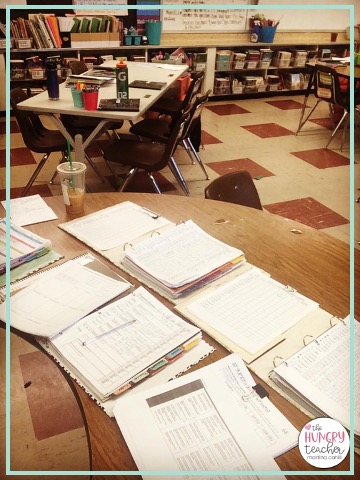
TEACHER MATERIALS ORGANIZATION
In the picture, you can see how I used to label them, but this was just plain obnoxious. I couldn’t find anymore of those dang metal things, without spending my entire weekend in Hobby Lobby, and most tab inserts I had wouldn’t fit. I also had to glue those on, my handwriting looked horrible, and honestly it was just a big waste of time.
Essentially it wasn’t a sustainable teacher organization system, especially the more I moved grade levels, and the more I learned to work smarter, not harder. The key is to make sure you find a system that works for you and one that you can keep up with no matter what.
The idea is to only have binders and printables of stuff you actually use and for the binders to make your day easier, not harder, and/or more time consuming.
At the end of the year, maybe even semester, really evaluate what resources you really need in your binders, and get rid of the stuff you don’t.


If you look closely, here you can see that I have significantly downsized by binder usage. Honestly this came from being in the same teaching position three years in a row.
At this point in my career, I wasn’t using the same stuff year to year because I was working on growing and evolving my instruction. I knew where my digital files were and could access them easily. I’d like to say that I’m better with dropbox and Google, and that’s why it’s gone down, but that’s not really true ha!
I am just better about saving digital files in an organized manner so that I can access them easily.
TEACHER MATERIALS ORGANIZATION
This may be THE BEST thing I have ever done in my seven years of teaching. (Ignore the Thursday label ha!) When I was self-contained, I just had one notebook for each subject. When I first started teaching two rounds of sixth grade ELA I did kind of the same, where I just used the same notebook for both classes. This was terrible because then the second class was just copying, I didn’t know how to pace how much time they needed to get the notes, and I wasn’t doing the important modeling of the work. I quickly realized I needed a notebook for every class and subject I use one for.
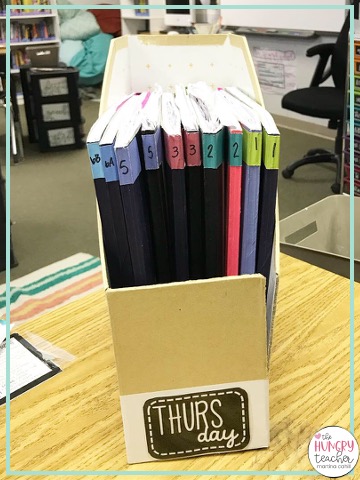
Even more so, I had to have them labeled on the spine so I could easily grab them and organize them for each class. This makes it so I don’t have to look through every notebook to find the one one I need. Each of my classes has two notebooks: One notebook has all their bell ringers and interactive notebook notes and the other notebook has all their reading responses and writing. The number labels are the class periods.

We created our notebook tabs and organization at the beginning of the year. It took us about two days to make them because we numbered every single page. There was a specific number of pages, for each section, but it is SO WORTH it the rest of the year. I will break these down for you on the next few pages.
These editable notebook tabs are available as an exclusive freebie for subscribers for you to utilize for student notebooks. These are an exclusive freebie for subscribers and are only otherwise available for purchase. Click here to get these sent straight to your inbox.
TEACHER MATERIALS ORGANIZATION
This is another 10-drawer cart I needed because of ALL THE PAPERS. They seemed to overcrowd my desks almost every single day. This gave me a space to put all the papers that needed to be graded for each class period. It’s also where I put my students’ paper when I am done grading them.
I put anything I need to file, in the “To file,” drawer. Anytime I have extra copies of a lesson plan we do I put it in the bottom drawer. If students need a copy they can dig in there. Honestly I eventually recycle most of my extra copies. I purchased the labels from Miss West Best on TPT.

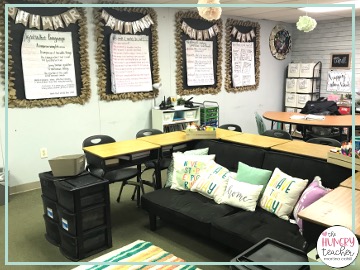
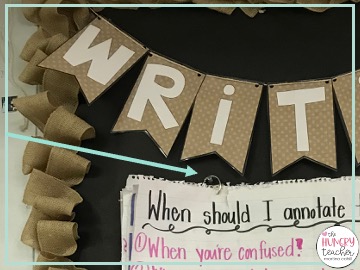
I saw this idea for bulletin boards on Instagram. This is mostly an image to show how I don’t create bulletin boards that are just a decoration. I have a modular so basically all my walls are bulletin board material. I simply, “created” four different bulletin boards for each of the subjects I teach.
Any time I create a chart paper, I just hang it up under its corresponding label. If I don’t have too many charts, I literally just tack them on top of each other.
If there are too many charts, I use the circle hook thingys haha and hang it one the tacks.
TEACHER DESKS ORGANIZATION
I know a lot of teachers have these teacher toolboxes for teacher organization, but here’s mine. I got the labels from Teach Create Motivate on TPT. The buckets on top are from the Target Dollar Spot. They are where I keep the things I grab all the time, because otherwise I stuff it in drawers and can’t ever find it.

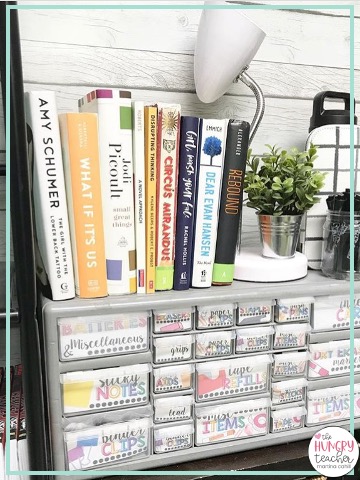
I’ve gotten more organized and way better at taking pictures (ha!) but my teacher toolbox has been a constant during the last three years.
I have moved my pens and things to a whole new organizer (I will show later). Honestly the buckets got knocked over all the time. They were cute but not practical.
This still isn’t a perfect organizational system. I used to shove all my cords into one big bin but then we couldn’t find the ones we needed. The cords are now organized by device. So all the Kindle cords are in one bucket, the “old” iPod cords in one, and the “new” iPod cords in another.
If we are charging something it just goes in the bucket above the outlet until it’s charged. I since added a fourth bucket for all of our headphones splitters.
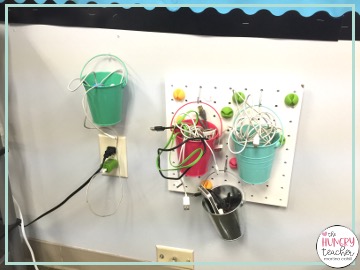

The previous picture shows how ugly things were ha! I liked that they were accessible, but I also try not to buy all the storage I could ever want when I want it. Eventually I bought three of these 10-drawer carts and used them for different kinds of organization storage. The cords eventually went into one of these drawers. You can see them sticking out, but WAY less ugly than before.
Classroom display systems
This is more of a teacher instruction idea, but a simple and effective idea nonetheless.
It’s a great way to use the limited amount of space you have. I put mine on the outside of your door if you have passing periods.
At my school, students can’t come into our rooms until we let them. They spend a good amount of time outside our doors. I created mini “bulletin boards” and have our word of the week and idiom of the week posted for them to learn each week.
The words are from Stacey Lloyd on TPT and the idioms are from Presto Plans on TPT.
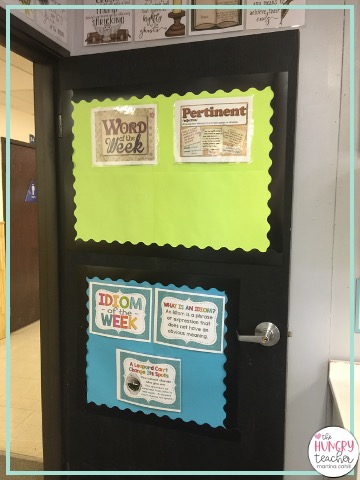
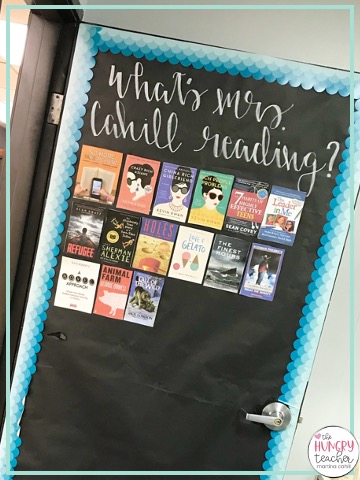
Like most things in teaching, this door has evolved over the years. I now use it to display the books I am reading. This became a much better use of the space. I use my bulletin boards for content related chart papers.
I’ve learned to really try and use every piece of my room for learning, without filling my space with too much “stuff.”
EXTRA MATERIALS ORGANIZATION
I feel like every year I have to use at least one bookshelf for all my “extra” stuff. The top shelf has some test prep books that I am actually just waiting to throw away (haha #sorrynotsorry).
The bottom two shelves have our dictionaries and thesauri for us to use during reading and writing if we don’t have access to computers.
My middle shelf has “art” supplies. Believe it or not, I teach an hour of 2nd/3rd grade art every day. I need the supplies accessible, but didn’t want them all used up before the year is over. A good bin with a cute label can make almost anything feel organized.
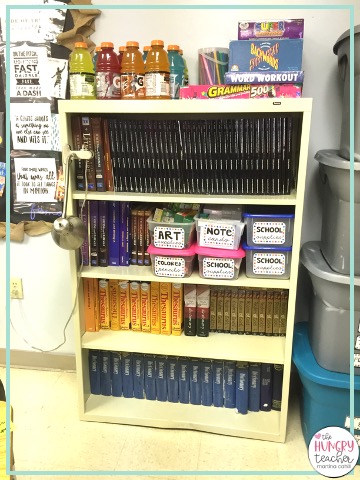

Like the images on the previous page, this space has also evolved. I honestly got rid of as many dictionaries and thesauri as possible. We use our computers and cells phones more than anything, so having about five of each was sufficient.
The rest of the books on top were old test-prep books and it was easy for me to throw those away. This made more room for book cub sets and extra copies. The rest of the dictionaries got hidden in the fabric bins on bottom.
This teacher materials organization blog post is part of a classroom organization series. This is part two of ten blog posts all about how I organize different areas of my classroom. Click on any of the links to be taken to each of the posts in the series:
- One: Lesson Planning and Lesson Materials Organization
- Two: Teacher Materials Organization
- Three: Student Materials Organization
- Four: Classroom Routines and Novels Organization
- Five: Classroom Library Organization
- Six: Book Clubs, Novel Sets, and Literature Circles
- Seven: Small Group Organization
- Eight: Grading and Assessment
- Nine: Long-Term and Short-Term Sub Planning
- Ten: Back to School Organization
CLICK HERE to get the ten-module organizational series, plus bonus resources for each module, sent straight to your inbox!
CLICK HERE to get the complete printable organization E-Book
This middle school English teacher grading strategies for upper elementary and middle school grading and assessment blog post is part of a classroom organization series. This is part eight of ten blog posts all about how I organize different areas of my classroom. Click on any of the links to be taken to each of the posts in the series:
- One: Lesson Planning and Lesson Materials Organization
- Two: Teacher Materials Organization
- Three: Student Materials Organization
- Four: Classroom Routines and Novels Organization
- Five: Classroom Library Organization
- Six: Book Clubs, Novel Sets, and Literature Circles
- Seven: Small Group Organization
- Eight: Grading and Assessment
- Nine: Long-Term and Short-Term Sub Planning
- Ten: Back to School Organization
CLICK HERE to get the Organization Overhaul Complete Classroom Course plus bonus resources for each module.
CLICK HERE to get the complete printable organization E-Book.
Get the Organization Overhaul Complete Classroom Course
Want a sneak peek at teaching The Hungry Teacher way—with support, structure, and strategy?
When you join the waitlist for The Hungry Teacher’s Hub membership, you get three free classroom-ready resources: a theme unit, an expository writing unit, and a grammar unit introducing mentor sentences. Plus, you’ll get immediate access to a selection of exclusives from the Hub, including editable sub plans, pacing guides, and more.
No strings attached. Just resources you can use right now—and a heads-up when the Hub opens.
3 Free Middle School ELA Units—yours to keep!
JOIN THE WAITLIST + A FREE GIFT
Where to next, line leader?
Welcome to The Hungry Teacher! We create resources that are easy to use, practical, and get results. Teach with confidence—and make it home before dinner.
xo, the hungry teacher
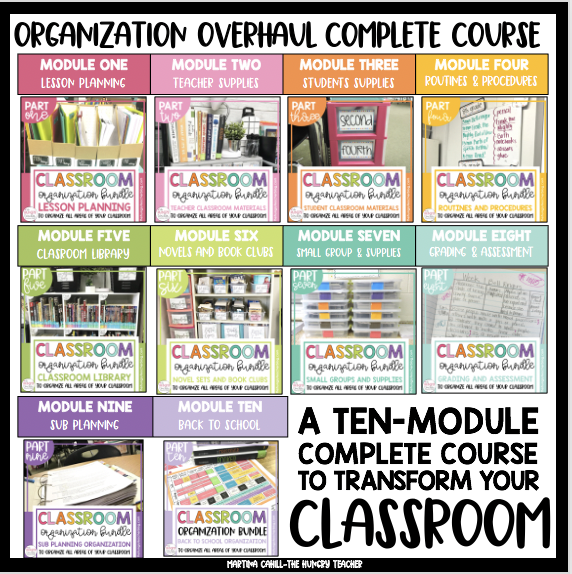
What did you use to create the tabs on the notebooks? Thanks for all the great ideas!
I'm wondering the same?!
Where did you get your colored labels for your composition books?
I do not even know how I stopped up right here, however I believed this put up was great. I don't recognise who you might be but definitely you're going to a famous postger for those who are not already 😉 Cheers! creative business ideas
I’ve been exploring for a little for any high quality articles or weblog posts in this sort of area . Exploring in Yahoo I ultimately stumbled upon this site. Reading this information So i am satisfied to convey that I have an incredibly good uncanny feeling I discovered just what I needed. I such a lot surely will make sure to do not fail to remember this site and provides it a look on a relentless basis.dynamic web design
Have you ever thought about adding a little bit more than just your articles? I mean, what you say is valuable and everything. Nevertheless think of if you added some great graphics or video clips to give your posts more, "pop"! Your content is excellent but with pics and videos, this blog could certainly be one of the very best in its niche. Superb blog! van singapore
Hmm it appears like your website ate my first comment (it was super long) so I guess I'll just sum it up what I wrote and say, I'm thoroughly enjoying your blog. I as well am an aspiring blog writer but I'm still new to everything. Do you have any tips for newbie blog writers? I'd genuinely appreciate it.Paint Correction ny